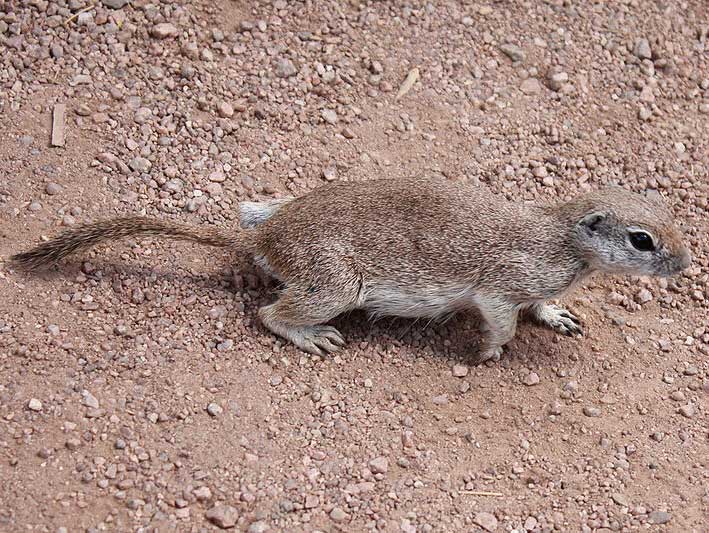
Xerospermophilus tereticaudus
Superregnum: Eukaryota
Regnum: Animalia
Subregnum: Eumetazoa
Cladus: Bilateria
Cladus: Nephrozoa
Superphylum: Deuterostomia
Phylum: Chordata
Subphylum: Vertebrata
Infraphylum: Gnathostomata
Superclassis: Tetrapoda
Cladus: Reptiliomorpha
Cladus: Amniota
Cladus: Synapsida
Cladus: Eupelycosauria
Cladus: Sphenacodontia
Cladus: Sphenacodontoidea
Cladus: Therapsida
Cladus: Theriodontia
Cladus: Cynodontia
Cladus: Mammaliaformes
Classis: Mammalia
Subclassis: Trechnotheria
Infraclassis: Zatheria
Supercohort: Theria
Cohort: Eutheria
Cohort: Placentalia
Cladus: Boreoeutheria
Superordo: Euarchontoglires
Ordo: Rodentia
Subordo: Sciuromorpha
Familia: Sciuridae
Subfamilia: Xerinae
Tribus: Marmotini
Genus: Spermophilus
Species: Xerospermophilus tereticaudus
Subspecies: X. t. apricus – X. t. chlorus – X. t. neglectus – X. t. tereticaudus
Name
Xerospermophilus tereticaudus (Baird, 1858)
Type locality: [Old] Fort Yuma [Imperial Co., California].
Synonyms
Citellus tereticaudus (Baird, 1858)
Spermophilus tereticaudus Baird, 1858 (Original combination)
References
Baird, S.F. 1857. Mammals. In: Reports of explorations and surveys, to ascertain the most practicable and economical route for a railroad from the Mississippi River to the Pacific Ocean 8, Part I. BHL Reference page. : 315
Helgen, K.M., Cole, F.R., Helgen, L.E. & Wilson, D.E. 2009. Generic Revision in the Holarctic Ground Squirrel Genus Spermophilus. Journal of Mammalogy 90(2): 270–305. DOI: 10.1644/07-MAMM-A-309.1 JSTOR PDF Reference page.
Links
Xerospermophilus tereticaudus – Taxon details on Integrated Taxonomic Information System (ITIS).
Vernacular names
English: Round-tailed Ground Squirrel
The round-tailed ground squirrel (Xerospermophilus tereticaudus), known as "Ardillón cola redonda" in Spanish, live in the desert of the Southwestern United States and Northwestern Mexico. They are called "ground squirrels" because they burrow in loose soil, often under mesquite trees and creosote bushes.
Characteristics
Most round-tailed ground squirrels are very small. Weight at birth is approximately 3.9 grams (0.14 oz). Adults weigh around 125 grams (4.4 oz).[2] All have a long round tail and long, hairy hind feet. They have no fur markings, instead having a uniform sandy color, which matches the soil they burrow in. The underside of their body is usually a lighter shade. Round tailed squirrels average 204 to 278 millimetres (8.0 to 10.9 in) in length including the tail which is from 60 to 112 millimetres (2.4 to 4.4 in) long.[3]
Lifecycle
The gestation period is 28 days. An average of 5.4 pups are born in each litter. They reach sexual maturity at 325 days. There is little information on the longevity of these animals but one wild born specimen lived to approximately 8.9 years in captivity.[2] They are prey animals for coyotes, badgers, hawks and snakes.
Behavior
Ground squirrels are well-adapted to desert life. They can stay active even on the hottest of days, although they do tend to limit their activity during the heat of the afternoon sun. They live underground in the winter, typically from late August or September until January or February. They go into torpor, but do not hibernate.
Social structure
They have a semi-colonial social structure, and will alert others of impending danger with a high-pitched alarm call. But they will chase away other ground squirrels who get too close to their own burrow. The males are dominant during the breeding season (January through March). The females dominate during the raising of the young (March and April).[4]
Distribution of the Round-tailed ground squirrel
A ground squirrel munches a velvet mesquite pod
Diet
Round-tailed ground squirrel peeking out from burrow
They are omnivores. The bulk of their diet is green vegetation, especially in the summer. They also eat seeds and insects (ants, termites, and grasshoppers). Most of their foods are chosen for high water content because of the shortage of available water in their environment. The average water content of the food they eat is 80%.[3]
References
Lacher, T.; Timm, R.; Álvarez-Castañeda, S.T. (2016). "Xerospermophilus tereticaudus". IUCN Red List of Threatened Species. 2016: e.T20493A22264318. doi:10.2305/IUCN.UK.2016-3.RLTS.T20493A22264318.en. Retrieved 12 November 2021.
AnAge entry for Spermophilus tereticaudus (HAGRID 03372),
Ernest, K., M. Mares. February 27, 1987. Mammalian Species. The American Society of Mammalogists.
Dunford, C. 1977. Kin selection for ground squirrel alarm calls. American Naturalist, 58: 782–785.
Retrieved from "http://en.wikipedia.org/"
All text is available under the terms of the GNU Free Documentation License

